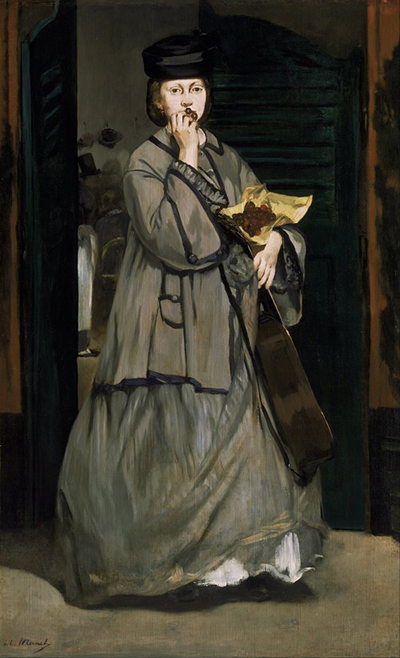The scene in Manet's Street Singer is typical of 1860's France. A young lady is leaving a sleazy cafe, possibly after a performance. She catches the eye of the artist briefly, pauses and then hurries away.
What is not typical, however, is Manet's reaction to the woman and the influence of her in his future work. The real life Street Singer is reputed to have refused permission for Manet to paint her, therefore he enlisted the help of Victorine Meurent to pose for him. Victorine soon became Manet's 'go-to' model in the 1860's and became a prominent figure in his change of direction.
Prior to the 1862 painting, Manet had focused on depicting scenes from history and the Bible. Street Singer saw him take a new direction; painting real life, however sleazy. Manet himself is noted to have stated it was time to "paint what you see". He began to paint friends of his, some who were known to be prostitutes and street entertainers. In the Street Singer, the woman wears drab clothing, clearly worn around the edges. She carries a guitar and is stuffing stark red cherries into her mouth. All of which point to a woman of disrepute. Respectable and refined woman did not wear such clothes and certainly did not eat fruit in public.
Following Street Singer, Manet painted Victorine a further 9 times, each painting becoming slightly more controversial. Victorine took Manet's works of art in a direction away from the sophisticated and aristocratic women he had previously painted. Victorine was shorter, plumper and generally unkempt, with her unruly ginger hair often on display from under her hat. In the next painting for which she sat (Le Déjeuner Sur L'Herbe, 1863), Victorine is seen entirely naked, in the company of 2 completely clothed men. Here, she is portrayed not as a shy nymph, embarrassed about her nakedness but as a woman in her own right, comfortable in her skin and challenging the viewer.
Olympia (1863) took Manet's boldness one step further as Victorine is portrayed as a prostitute, post-coitus with a servant attending to her. The public reaction to this change of direction was varied, though most agreed the works of art were 'crude' and at times indecent. His friends remained loyal, with close friend and critic Emile Zola stating of Street Singer that it was 'beautiful' and a thoughtful confrontation of real life. Regardless of the critics initial opinions of Street Singer, Manet continued to pursue this direction with great success and continued to inspire the young modernists and impressionists of the time.




